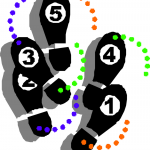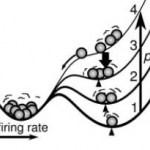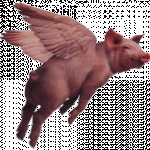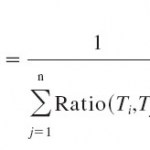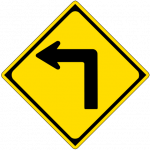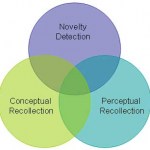A fascinating paper from Gradinaru et al describes a genetically engineered mouse model of Parkinson's disease that expresses a photoreceptor in the neurons of a particular part of the brain - the subthalamic nucleus (STN). This area is widely thought to be the central target of the immensely therapeutic technique for Parkinson's known as deep brain stimulation. With this photoreceptor in place, the authors could direct laser light to that area of the brain and direactly affect neural activity - in particular, whether the behavioral symptoms of Parkinson's would disappear following…
A number of very smart people (and smart communities) seem like they might be under the impression that the "voodoo correlations" scandal in the neuroimaging community is somehow related to recent work by Bennett et al, who used fMRI to show task-related neural activity in a dead fish.
These two things have almost nothing to do with one another.
1) The Bennett work is, in the words of a friend, "a cute way to make a point" that every fMRI paper I've ever read has failed to explicitly acknowledge. The reason they've failed to acknowledge it is that it's standard to run equivalent statistical…
Something's afoot when a massively parallel and distributed system shows a bottleneck in performance. We've known that numerous bottlenecks plague cognition since the 1940's, but only with recent advances in neuroimaging have we been able to say whether these bottlenecks reflect the intrusion of executive operations (for managing goals and organizing cognitive processing) or a more passive "queueing" processes inherent to the selection of responses. Thanks to a number of very helpful (and interesting) reviews on a recent paper of mine, I've been pointed towards a fascinating study (by Jiang…
Children assigned to chew sugar-free gum purportedly score 3% higher on standardized tests of math skills (as widely reported in the press). But is this just one of the 5% of all possible untrue hypotheses statistically guaranteed to have some significant result in its favor (in fact, it's worse than that)? Is the effect due to some other aspect of gum chewing (as Michael Posner asks)? Or might there be a real effect here of chewing (i.e., "mastication"), and if so, how can you use it to your maximum advantage?
What we know - and what we don't - about gum and cognition
To cut to the chase…
How many times did Pavlov ring the bell before his dogs' meals until the dogs began to salivate? Surely, the number of experiences must make a difference, as anyone who's trained a dog would attest. As described in a brilliant article by C.R. Gallistel (in Psych. Review; preprint here), this has been thought so self-evident "as to not require experimental demonstration" - yet information theoretic analysis suggest the idea is incorrect, at least when the time from the bell to the food is constant. More problematic is the fact that the whole issue is ill-formed for experimental verification…
Don't think of a white bear. Doesn't work so well, does it? Yet under some circumstances, people appear to be able to do precisely this: as described last week, young adults are thought (by some) to actually suppress the neural activity related to to-be-ignored stimuli, and even delay the peak of this neural activity, relative to a situation in which stimuli are to be just passively-viewed. In a follow-up paper at Nature Neuroscience, Gazzaley et al report that cognitively-intact older adults (60-77 years of age) show an impairment in this ability, without concomitant impairments in the…
The cognitive neurosciences have had high frequency oscillations on the brain: so called "gamma-waves", as recorded on the scalp, have been linked to working memory processes (via their interaction with slower "theta waves"), to cognitive insight, and even to consciousness. (I think there's an unwritten rule that whenever someone mentions consciousness, they'll be made to look foolish by a subsequent paper). In the midst of these "inflationary accounts" of the role of gamma oscillations, a debate has emerged: could these oscillations (at least, as recorded on the scalp) reflect simply the…
By many current theories, we accomplish control over behavior by using the prefrontal cortex to "bias" the competitive dynamics playing out in the rest of the brain. By some models, this bias is positive - it helps the goal-relevant representations win the competition. By other models, the bias is also negative - it can help the goal-irrelevant representations lose the competition. Regardless, this "prefrontal biasing" is usually considered in terms of the amount of activity in a particular area (higher when that area is under a positive bias, and lower when under a negative bias). But…
A new study suggests that physically stepping backwards may be associated with gains in the ability to deal with problematic situations. As newly reported in Psychological Science (hat tip to Hannah) by Koch, Holland, Hengstler & Knippenberg, people were better able to resolve interference in laboratory "Stroop" task after stepping backwards, relative to stepping to the side or forwards. The authors argue that stepping backwards is typically associated with problematic situations, which characteristically require cognitive control (the set of capacities which enable us to control our…
Every now and then, I read some science from some other dimension. That is, the methods are so unusual, the relevant theories so fringe, or the conclusions so startling that I feel like the authors must be building on work from a completely separate science, with its own theories and orthodoxy. This can be good or bad, and is usually the latter. But in the case of Zhang & Luck's recent papers, it's very, very good.
To appreciate what they've done, here's a little background from this dimension's science - specifically, the science of forgetting. The phenomenon of "forgetting" has been…
There are three on-off light switches on the wall of the first floor of a building. One of the switches is initially off and controls an incandescent bulb in a lamp on the third floor of the building. The other two switches do not control the bulb or anything else (they are disconnected). How can you find out which one of the three switches turns the light bulb on and off? You can toggle the switches as many times as you want and for as long as you want, but you can walk only once to the third floor to check on the light bulb.
While you're working on that, I'll show you what you look like (…
Most computational models of working memory do not explicitly specify the role of the parietal cortex, despite an increasing number of observations that the parietal cortex is particularly important for working memory. A new paper in PNAS by Edin et al remedies this state of affairs by developing a spiking neural network model that accounts for a number of behavioral and physiological phenomena related to working memory.
First, the model: Edin et al simulate the intraparietal sulcus (IPS; with ~1000 excitatory units and 256 inhibitory units) and the dorsolateral prefrontal cortex (dlPFC;…
A number of previous behavioral and neuroimaging experiments, as well as computational models, support the idea that people can filter the contents of memory and perception so as to focus on only the information that's currently relevant. For example, in a visually-complex environment, distracting items often go unprocessed by the human visual system, perhaps due to some low-level perceptual bandwidth limitations. However, in cognitively-complex environments (when working memory, but not perception, is loaded to capacity), distractors are more likely to be processed (this is Lavie et al's…
One theoretical model of the prefrontal cortex posits that we can achieve goal-directed behavior via "biased competition" - that is, representations of our current goals and context are maintained in the prefrontal cortex and exert an influence on downstream areas, ultimately biasing our behavior in a goal-directed and context-appropriate way. By theory, this relatively simple function is enhanced by the anterior cingulate, functioning as a "conflict monitor" and upregulating the PFC when this so-called biased competition is a little too competitive, and not quite biased enough. However,…
A principal insight from computational neuroscience for studies of higher-level cognition is rooted in the recurrent network architecture. Recurrent networks, very simply, are those composed of neurons that connect to themselves, enabling them to learn to maintain information over time that may be important for behavior. Elaborations to this basic framework have incorporated mechanisms for flexibly gating information into and out of these recurrently-connected neurons. Such architectures appear to well-approximate the function of prefrontal and basal ganglia circuits, which appear…
When reading the title of this post, your knowledge of the world was sufficient to let you interpret the phrase "when pigs fly," but also alerted you to the fact that it is inconsistent with much of that world knowledge: clearly, pigs don't fly. A new study by Menenti, Petersson, Scheeringa & Hagoort localizes the neural basis of this "anomaly processing" to a particular region of the prefrontal cortex - the inferior frontal gyri - and finds that the local context surrounding such anomalies (say, that you're told hell has frozen over) has much stronger effects in one hemisphere than the…
A lot has been written about domain-general processing in prefrontal cortex, and a very old lesson often gets overlooked: there are very basic hemispheric asymmetries (particularly in PFC) that divide information processing by modality. A very nice study by Morimoto et al provide a nice reminder of this important feature of neuronal organization, and illustrates that very specific regions of PFC are the only ones to show such hemispheric specialization in tasks that require cognitive control.
Morimoto et al first trained subjects to press (for example) button "1" in response to "RED", "BLUE…
It's been said that psychology is a primitive discipline - stuck in the equivalent of pre-Newtonian physics. Supposedly we haven't discovered the basic principles underlying cognition, and are instead engaged in a kind of stamp collecting: arguing about probabilities that various pseudo-regularities are real, without having any overarching theory.
Some of this criticism is deserved, and some of it applies more widely to the life sciences. Perhaps the only underlying principle in biology is "why use just one solution when using many works just as well?" (Natural selection is no exception to…
Reductionism in the neurosciences has been incredibly productive, but it has been difficult to reconstruct how high-level behaviors emerge from the myriad biological mechanisms discovered with such reductionistic methods. This is most clearly true in the case of the motor system, which has long been studied as the programming of motor actions (at its least reductionistic). However, as pointed out by Mars et al., the brain is almost constantly enacting motor plans, and so the initiation of actions is more likely preceded by motor reprogramming than anything else. However, that process has…
An astonishing recent discovery in computational neuroscience is the relationship between dopamine and the "temporal differences" reinforcement learning algorithm (which Jake describes wonderfully here, and I've described in a little more detail here). The essential principle is that the difference between expected and received reward can be used to drive learning, and that this abstract learning theory can be tracked by the spikes and dips of dopamine in vivo (for under-expectation and over-expectation of reward, respectively).
However, one aspect of dopamine release is not accounted for…


